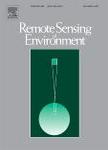版权所有:内蒙古大学图书馆 技术提供:维普资讯• 智图
内蒙古自治区呼和浩特市赛罕区大学西街235号 邮编: 010021

作者机构:CSE INRA Avignon F-84914 Avignon 9 France
出 版 物:《REMOTE SENSING OF ENVIRONMENT》 (环境遥感)
年 卷 期:2004年第93卷第1-2期
页 面:53-67页
核心收录:
学科分类:12[管理学] 0830[工学-环境科学与工程(可授工学、理学、农学学位)] 1201[管理学-管理科学与工程(可授管理学、工学学位)] 1002[医学-临床医学] 08[工学] 0816[工学-测绘科学与技术]
基 金:Deutsche Forschungsgemeinschaft DFG
主 题:radiative transfer model inverse problem regularization object-based modeling numerical experiment Landsat TM texture leaf area index leaf chlorophyll content equivalent leaf water thickness artificial neural net
摘 要:The retrieval of biophysical variables using canopy reflectance models is hampered by the fact that the inverse problem is ill-posed. This leads to unstable and often inaccurate inversion results. In order to regularize the model inversion, a novel approach has been developed and tested on synthetic Landsat TM reflectance data. The method takes into account the neighbouring radiometric information of the pixel of interest, named object signature. The neighbourhood data can either be extracted from gliding windows, already segmented images, or using digitized field boundaries. The extracted radiometric data of the neighbourhood pixels are used to calculate 42 descriptive statistical properties that comprehensively characterize the spectral (co)variance of the image object (e.g. mean and standard deviation of the distributions, intercorrelations between spectral bands, etc.). Together with the habitual spectral signature of the pixel being inverted (6 variables), this object signature (42 variables) is used as input in an artificial neural net to estimate simultaneously three important biophysical variables (i.e. leaf area index, leaf chlorophyll, and leaf water content). The use of neural nets for the model inversion avoids time-consuming iterative optimizations and provides a computational effective way to consider simultaneously pixel and object signatures. In order to learn the relation between spectral signatures and biophysical variables, the neural nets were previously trained on large synthetic data sets. The data sets consist of pixel signatures and the corresponding signatures of image objects representing various agricultural fields. The signatures were simulated with the SAILH+PROSPECT canopy reflectance model, assuming largely varying intra-and interfield distributions of the model input parameters. To demonstrate the benefits of the object-based inversion, neural nets were also trained on the pixel signatures alone. For this purpose, the object signat